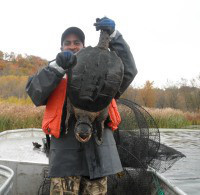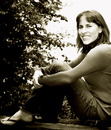Erin Keyser Horn's Blog, page 5
April 22, 2013
TREE Interview #7: Lori Neuman-Lee
Welcome to the seventh of the TREE interviews! Click HERE to read more about the TREE program and its relevance to my book, RIVER’S EDGE.
Today I (Erin) am interviewing Lori Neuman-Lee!
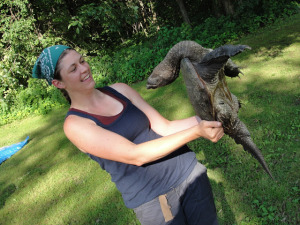
Lori and a snapping turtle. I call this Turtle Yoga. 
E: Hi Lori! Tell us the years you were at Thomson Causeway.
L: I was at the causeway for at least part of Turtle Camp from the years 2003-2012.
E: At the time, were you a student in high school, college, or graduate school? If you were conducting research, what was your focus?
L: I began as an undergraduate student in 2003, but as I was the cofounder and coordinator of TREE, I continued as a Master’s student when I went to a different university. I conducted research (ironically) off the Causeway, about an hour south. I was working with map turtles. However, my long term project and focus was trapping in the slough. I did intensive trapping for the nine years that I worked at Turtle Camp.
E: How did you first decide to participate in the TREE program?
L: Shannon Thol, Jeramie Strickland, and I decided that Turtle Camp was an optimal place to institute an education outreach program. We worked together with Fred to develop the program.
E: What was your favorite part of TREE?
L: There are many things over the years that I loved about TREE. Since I was the coordinator or co-coordinator (depending upon the year), I received the applications and was able to follow the students throughout their high school and then college years. Each student took a survey prior to TREE and the last day of TREE. I loved reading how much they learned. It was also incredible to watch a group of students that had individuals from many different backgrounds. The first few days were always a bit strained, but then the students would band together and work as a team. The team structure really helped with that.
E: Can you share an anecdote or funny story about your time there?
L: There are so many over the years. I have three stories that I think exemplify the spirit of TREE. The first one came after the first night of the first TREE. Shannon, Jeramie, and I admittedly didn’t know what we were getting ourselves into. We thought we had planned for everything. After the first night, one of the girls came up to me and confided that she had been cold the night before. I was initially very confused, given that they had warm sleeping bags. Then she told me that the blankets we had given them were very narrow and didn’t cover her. This young woman had never used a sleeping bag. It was a truly new experience. Everything.
The second story is one that I also love. I led the trapping team every year and the first few days were often difficult due to the lack of experience in canoeing. We usually had to set traps, which is difficult with experienced canoers, but really challenging when you have students with you who have never sat in a canoe, much less controlled one. There was a young student who was a horrible, horrible canoer. She was paddling by putting her paddle in parallel to the water instead of perpendicular. She improved, as all students do. However, the next year she returned and we went out into the water. As we pushed off and began canoeing, I realized that she was now an experienced canoer! This individual continued as a high school mentor and then as an undergraduate mentor and has helped to make the program stronger.
The final story involves many smaller stories and encompasses the fun of TREE. There is a history of harmless pranks. One year, there was a team attempting to use wildlife cameras to capture a turtle nest predator. The other two teams spent one afternoon covertly making raccoon masks. That night, we slipped out and set off the cameras, pretending to be raccoons. There was retribution, however. Two mornings later, the trapping team (my team) went to check the traps. It was a particularly cold morning. Our canoes were moored in the middle of the slough! The other teams had borrowed a kayak and pulled our canoes out. We had no choice but to swim through the slough to gather our canoes.
E: How did TREE benefit you later in your education or career?
L: TREE was immensely beneficial to me. I learned a great deal about how to manage a bunch of students. I learned how to work with a diverse group of kids and recognize their strengths and their weaknesses. It was a steep learning curve, but I see where the students are now in their lives and it makes me feel proud and gratified to see so many of them successful. I know that the TREE program changed the lives of a lot of the kids. And Jeramie, Shannon, Fred, and I started that. It’s one of the most important things I’ve ever done in my life.
E: Who would you recommend the TREE program to, and why?
L: I’d recommend it to anyone that loves learning. It’s not always easy or pleasant. It can be miserable at times to be out in the cold rain watching turtles. Sometimes it involves late nights. But it’s all worth it. At the end of the two weeks, you feel like you accomplished something and everyone has bonded in a way that is hard to achieve.
E: Is there anything else you’d like people to know about TREE?
L: It’s valuable to support programs like TREE. It nurtures the individuals that may not fit into traditional roles. It helps build skills other than just research. Students have to think. They have to work together. They have to be respectful. Students have ownership of their work and their results. It’s important.
Lori, thanks so much for taking the time to answer my questions and share your stories! Every time I think about the huge impact that you, Shannon, and Jeramie had by starting the TREE program, I get chills (in a good way!). Thank you for all you do to develop future biologists!
Readers, 10% of RIVER’S EDGE sales through May 5th will be donated to the TREE program. Help support future turtle research and young biologists!


April 21, 2013
TREE Interview #6: Maribel Piñon
Welcome to the sixth of the TREE interviews! Click HERE to read more about the TREE program and its relevance to my book, RIVER’S EDGE.
Today I (Erin) am interviewing Maribel Piñon!
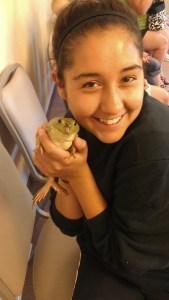
What a sweet picture, Maribel!
E: Hi Maribel! Tell us the years you were at Thomson Causeway.
M: 2008—2012.
E: At the time, were you a student in high school, college, or graduate school? If you were conducting research, what was your focus?
M: Both in high school and an undergraduate in college; my focus was on the western hognose snake microhabitat selection.
E: How did you first decide to participate in the TREE program?
M: I first decided to attend TREE when I was a junior in high school because I saw the description and I really liked what they had to offer. I was really looking forward to working with professors, and especially the animals.
E: What was your favorite part of TREE?
M: There are a lot of things that I like about TREE, but I think the best part is that even though I am working it doesn’t feel like work and that I am always having a great time.
E: Can you share an anecdote or funny story about your time there?
M: My absolute favorite story from turtle camp is when my best friend Jessica called out for my help. We had gotten done with work and our shower runs. I was lying in bed and snuggled up and ready to fall asleep when I hear Jessica call my name. “Maribel, can you come help, there is a spider in my tent.” Of course I said to myself really I am so comfortable in my sleeping bag, but I decided to go out and help her. She asks me if I could hold her light so she could get the spider out, but the action of just how scared she was . . . well, too hilarious to not laugh. So there I am laughing and Jessica decides that by telling me, “Hold it steady (the flashlight),” everything would be better, but that made me laugh even more! We eventually lost the spider. She took everything out of her tent and she just couldn’t find the spider. I decide to be a good friend and ask her if she wants to sleep in my tent and of course she says yes. The next morning, first thing we do is search her tent for the spider and we still couldn’t find it. When I suddenly see the spider not in the tent but in her hair. I respond with, “Jessica I found the spider,” and she said, “Where?” and to that I responded with, “In your hair!”
E: How did TREE benefit you later in your education or career?
M: When I entered Iowa State I was very comfortable. I knew a professor and graduate students that I could go to their office to ask for advice. It was my first day of college and I was already part of a research lab. Not many freshmen could say that, and I felt very honored and privileged.
E: Who would you recommend the TREE program to, and why?
M: I would recommend TREE to anyone. Even if you have no interest in research you learn so much, and you could change your career goals. I went into TREE thinking I was going to become a veterinarian. In my second year of TREE I decided that instead of veterinary school I would go to graduate school to conduct more research of my interest.
E: Is there anything else you’d like people to know about TREE?
M: TREE is a place to learn, not only about ecology and research, but you also learn about yourself and what you want for a career goal. The best part is the people you meet. You spend 24/7 with them. That may seem too much and that you would get annoyed with them, but in reality they become your best friends. You all have something in common so conversations never end. The friendship will always be there, and the networking you do with graduate students and with Fred (Dr. Janzen) is great. They all have been a great contribution to my career and they become amazing mentors.
Maribel, thanks so much for taking the time to answer my questions! So great to hear about your experiences with TREE, and how it even influenced your choice of career! 
Readers, 10% of RIVER’S EDGE sales through May 5th will be donated to the TREE program. Help support future turtle research and young biologists!


April 19, 2013
TREE Interview #5: Sarah Mitchell
Welcome to the fifth of the TREE interviews! Click HERE to read more about the TREE program and its relevance to my book, RIVER’S EDGE.
Today I (Erin) am interviewing Sarah Mitchell!
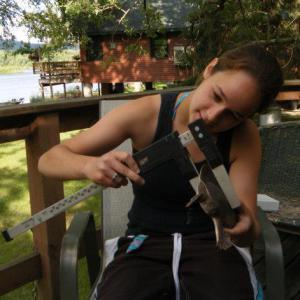
Sarah, working the caliper!
E: Hi Sarah! Tell us the year you were at Thomson Causeway.
S: I started my work at Turtle Camp in early June of 2012.
E: At the time, were you a student in high school, college, or graduate school? If you were conducting research, what was your focus?
S: I was just beginning my graduate studies at the time. I was focusing on getting a feel for the TREE program and the research program at Turtle Camp to help me think about the directions my graduate research could take, since I’ll be there for the next four years.
E: How did you first decide to participate in the TREE program?
S: Since biology is a large part of my life and a pressing current issue, I’m passionate about outreach and education. The TREE program played a significant part in my decision to go to Iowa State, and I was excited to participate!
E: What was your favorite part of TREE?
S: Working with the high school students! They’re a lot of fun, and I really enjoyed sharing field work experiences with them.
E: Can you share an anecdote or funny story about your time there?
S: Hmm… one of my favorite parts of TREE was trying to catch a racer (very fast snake) in the sand prairie with a group of the TREE students. We didn’t catch it, but the chase was fun!
E: How did TREE benefit you later in your education or career?
S: For me, TREE is a great way to develop skills in education and outreach. I feel that my generation of biologists needs to engage the public and educate students to an unprecedented degree, and I’m grateful for the chance to hone those techniques.
E: Who would you recommend the TREE program to, and why?
S: I’d recommend it to anyone with a good work ethic, positive attitude, and a curious mind. I think TREE is a great opportunity to learn about ecology, engage the natural world, and meet interesting people!
Sarah, thanks so much for taking the time to answer my questions! I love your enthusiasm for sharing biology with students and the public. Good luck with your graduate studies! ;-)
Readers, 10% of RIVER’S EDGE sales through May 5th will be donated to the TREE program. Help support future turtle research and young biologists!


TREE Interview #4: Jessica Maciel Hernandez
Welcome to the fourth of the TREE interviews! Click HERE to read more about the TREE program and its relevance to my book, RIVER’S EDGE.
Today I (Erin) am interviewing Jessica Maciel Hernandez!
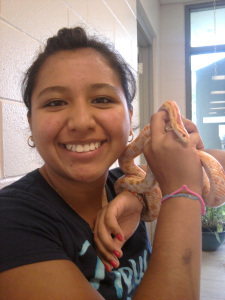
Great picture, Jessica!
E: Hi Jessica! Tell us the years you were at Thomson Causeway.
J: I was there the summers of 2007, 2008, 2009, 2010, 2011, and 2012.
E: At the time, were you a student in high school, college, or graduate school? If you were conducting research, what was your focus?
J: I started after my freshman year in high school, so I did TREE for 3 years. Then I became a mentor for the TREE program after I graduated high school, and my last years I worked as an undergraduate research assistant. One of those years I was able to be an NSF REU intern, and I focused on the microhabitat selection of Hognose snakes.
E: How did you first decide to participate in the TREE program?
J: I am in a program called Science Bound, which is a scholarship program for Iowa State Students, who are a minority, majoring in a Science, Technology, Engineering, and Mathematics (STEM) career. One of the requirements for the program is that each summer we complete a STEM related activity. One of my high school teachers heard about TREE, so that’s what I did one of those summers, and I’ve done it ever since.
E: What was your favorite part of TREE?
J: I have many favorites, but mostly was learning how to live outside because we literally camped out for weeks, and seeing how we did real research and came up with our own research questions also. Working with graduate students was also a great learning experience.
E: Can you share an anecdote or funny story about your time there?
J: Again there are many, but personally, I was setting out traps in the backwaters of the Mississippi River. It’s really difficult canoeing, setting out traps with two people in a canoe, and the canoe full of net traps. So the difficult part is putting them into the bottom of the water so they don’t fall and sink, and in order to do that you have to stand up on the canoe to push them in really good. So I stood up and as soon as I sat back down, balance was lost because of all the weight of the nets, and the whole canoe tipped over. Me and the other person fell in, and the traps and the boat sunk down.
E: How did TREE benefit you later in your education or career?
J: It has benefited me especially in deciding what I want to do with my career, because I get to see first-hand what graduate students do, and it has given me research experience which has helped me get other jobs and work with other professors.
E: Who would you recommend the TREE program to, and why?
J: I would recommend the TREE program to everyone who is planning on going into a career of education, science, and research. It’s for different types and age groups, not just high school students, because the graduate students and professors learn from the students, and the students also learn from the professors and graduate students.
E: Is there anything else you’d like people to know about TREE?
J: Learn about what it is! And try to do a program similar to it because it really works for kids and everyone else to get interested in science!
Jessica, thanks so much for taking the time to answer my questions! It’s awesome that you were involved with TREE for so many years. And I love that tipped-canoe story—something similar happens in my book. ;-)
Readers, 10% of RIVER’S EDGE sales through May 5th will be donated to the TREE program. Help support future turtle research and young biologists!


April 18, 2013
TREE Interview #3: Andrew Durso
Welcome to the third of the TREE interviews! Click HERE to read more about the TREE program and its relevance to my book, RIVER’S EDGE.
Today I (Erin) am interviewing Andrew Durso!
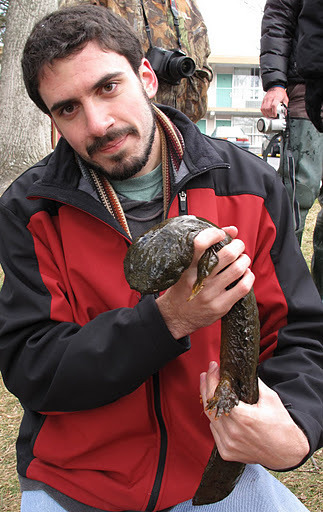
Andrew Durso! Bonus points if you know what animal he’s holding. 
E: Hi Andrew! Tell us the years you were at Thomson Causeway.
A: I first visited in October 2009 and spent all summer there in 2010 and 2011. I last was there in summer of 2012 for the Turtle Camp 25 year Reunion.
E: At the time, were you a student in high school, college, or graduate school? If you were conducting research, what was your focus?
A: I was a Master’s student at Eastern Illinois University during the majority of my time at TREE. My research focused on the behavior and ecology of the Western Hog-nosed Snake (Heterodon nasicus) population on the nearby sand prairie.
E: How did you first decide to participate in the TREE program?
A: My colleague Lori Neuman-Lee made me aware of the dense population of Western Hog-nosed Snakes on the Thomson Sand Prairie in 2009. I decided to do my MS research there before I knew much about TREE, but because I was living and working at the Turtle Camp site during the summers of 2010 and 2011, I became involved as a de facto TREE mentor, particularly for the TREE students working on the sand prairie team. Once I had participated for one year, I was eager to go back in 2011 and took a more active role in mentoring students, although I was never officially a TREE mentor.
E: What was your favorite part of TREE?
A: It is so inspiring to see students from highly urban areas involved in scientific research in a natural setting. The Thomson Sand Prairie is one of the few intact sand prairies in Illinois, and many of the TREE students probably had never seen any truly natural ecosystem before, let alone such a unique one. I started my career in herpetology as an educator, and I have seen time and time again the power of live animals to engage and educate people. Furthermore, camping is a great leveler: from college professors to high school students, everyone takes a turn with the dishes, which fosters a real sense of community and equality. However, I think my favorite part about TREE is how it contrasts with other field research I have done—the daily interactions with interested students help keep my attitude toward sometimes discouraging or monotonous field tasks positive.
E: Can you share an anecdote or funny story about your time there?
A: High school and college students (OK, and graduate students too) love a good prank. More than once the majority of the TREE camp had their tents zip-tied shut or their tent stakes pulled out. A little humor goes a long way toward a positive environment.
E: How did TREE benefit you later in your education or career?
A: I was able to produce a great deal of data from my two years at TREE, thanks mostly to the help of the TREE students and other participants. Without the help of these individuals, I would never have been able to generate such a large data set for my MS work. These data are currently in preparation for publication, with one article in review at the journal Ethology and the other in preparation for submission to the journal Oecologia. Furthermore, I often correspond with other TREE mentors, and I have since been invited to collaborate on other research projects as a result of my work at TREE.
E: Who would you recommend the TREE program to, and why?
A: Any high school or college student interested in field ecology. There is no better way to learn than by doing. If you can’t attend TREE, find a similar program near you, or collaborate with scientists to start one of your own.
E: Is there anything else you’d like people to know about TREE?
A: The experience is irreplaceable, but funding is becoming more limited due to cuts to the federal budget for scientific research. Write your congressmen and tell them that science and science education need federal support.
Andrew, thanks so much for taking the time to answer my questions! I really enjoyed the insights you shared. Good luck with your thesis and articles!
Readers, don’t forget that 10% of April sales of RIVER’S EDGE will be donated to the TREE program. Help support future turtle research and young biologists! :-)


April 17, 2013
TREE Interview #2: Jaymie Reneker
Welcome to the second of the TREE interviews! Click HERE to read more about the TREE program and its relevance to my book, RIVER’S EDGE.
Today I (Erin) am interviewing Jaymie Reneker!
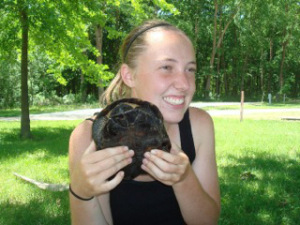
Jaymie Reneker! Love to see this much happiness for field biology!
E: Hi Jaymie! Tell us the year you were at Thomson Causeway.
J: I participated in Turtle Camp during the summer of 2011.
E: At the time, were you a student in high school, college, or graduate school? If you were conducting research, what was your focus?
J: I was an undergraduate student helping with Dr. Janzen’s research as well as conducting my own research project. My focus was on how successful different painted turtle nests were based on the female who laid them. We compared the size and shape of the female with how many eggs she laid and how well the nest hatched to better understand the painted turtle.
E: How did you first decide to participate in the TREE program?
J: I was an undergraduate research assistant in Dr. Janzen’s lab for the semester prior to Turtle Camp. Dr. Janzen asked me to help him with his research over the summer and I could not have been more excited to do so. It allowed me to continue research in the field with great colleagues.
E: What was your favorite part of TREE?
J: My favorite part was definitely the people I got to meet and spend the entire summer with. Everyone that participates in TREE is hard working, dedicated and excited to learn more. I got to work with high schoolers all the way to post doctorates and professors. The wealth of knowledge from everyone was incredible. I also really enjoyed being in the field 24/7 doing research in turtles and other reptiles.
E: Can you share an anecdote or funny story about your time there?
J: I spent the summer with 3 other undergraduate students. We all instantly clicked and were inseparable for the entire summer. The summer that we spent at the Thompson Causeway was accompanied by no water. This forced us to ride our bikes across the island to get water for showers. It was never a dull moment at our camp. We spent a lot of our time doing research but in our off time, we made dinner and hung out by the camp fire. We even played pranks on each other and our supervisors. It was a never ending cycle of fun!
E: How did TREE benefit you later in your education or career?
J: After my summer with TREE, I finished my senior year in college. I was then accepted for an internship with the Bald Head Island Conservancy doing sea turtle research, which was always my dream. The skills I learned at Turtle Camp greatly impacted my selection into the program as well as made me feel confident in my new internship. The Bald Head Island Conservancy then hired me to be their Sea Turtle Program Coordinator for this coming summer. I would not be where I am today if it were not for my summer with TREE.
E: Who would you recommend the TREE program to, and why?
J: I would recommend TREE to anyone interested in field research. You learn everything from basic field techniques to how to live and work with fellow researchers in the field. It will give you the experience and confidence you need to continue in a biological and research based field.
E: Is there anything else you’d like people to know about TREE?
J: TREE is an incredible program and opportunity for high school students and college students alike. You will meet incredible people and do amazing research. It is definitely a summer I, and you, will never forget!
Jaymie, thanks so much for taking the time to answer my questions! And congratulations on your new job as Sea Turtle Program Coordinator—that’s awesome!
Readers, don’t forget that 10% of April sales of RIVER’S EDGE will be donated to the TREE program. Help support future turtle research and young biologists! :-)


April 16, 2013
TREE Interview #1: Jeramie Strickland
Welcome to the first of the TREE interviews! Click HERE to read more about the TREE program and its relevance to my book, RIVER’S EDGE.
Today I (Erin) am interviewing Jeramie Strickland, a wildlife biologist for the US Fish & Wildlife Service.
E: Hi Jeramie! Tell us the year(s) you were at Thomson Causeway.
J: From 2006-present.
E: At the time, were you a student in high school, college, or graduate school? If you were conducting research, what was your focus?
J: Started working on the Turtle Camp project during my master’s thesis research work. Now I am working full time on the Refuge where the Turtle Camp site is located. I also worked for the Ecological Society of America previously. In 2006, I sat down with Dr. Janzen and my colleagues (Lori Neuman Lee, Shannol Thol) about my ideas in starting a research program for high school students from urban areas. This idea had been on my mind for a while, especially since I was from Chicago. Fred, Shannon, and Lori were receptive of the idea, and the rest was history (smile). Both Fred, Lori and Shannon were the back bone in helping to start the program.
E: What was your favorite part of TREE?
J: Seeing the high school students grow to learn more about field biology, designing their own research project, collecting and analyzing the data, and presenting their work at our FWS Learning Center for the final phase of their internship.
E: Can you share an anecdote or funny story about your time there?
J: In 2010, students were alarmed that their was a creepy guy “stalker” in the woods following them around for several days on and off. Students lost sleep, went to bathrooms in groups, and were alarmed. Come to find out, it was a land surveyor (smile). Also we thought one student was missing, but found the student sleeping in the van the following morning.
E: How did TREE benefit you later in your education or career?
J: Working with the Turtle Camp and TREE crew helped me get my foot in the door with the US Fish and Wildlife Service where I am now a Wildlife Biologist.
E: Who would you recommend the TREE program to, and why?
J: Everyone! Never know the value in networking and spreading the word to attract more diverse audiences into science.
E: Is there anything else you’d like people to know about TREE?
J: It’s the model program to get youth connected to the outdoors and interested in pursuing environment and science related careers. They learn that science, is cool and fun. And the students are able to see the broader implications of their field work.
Jeramie, thanks so much for taking the time to answer my questions! I love that you had the original idea for providing research opportunities for HS students in urban areas—VERY cool! :-) I’m sure you’ve motivated several aspiring biologists over the years.
Readers, click HERE to read more about Jeramie’s background and current job as a wildlife biologist. And remember that 10% of April sales of RIVER’S EDGE will be donated to the TREE program. Help support future turtle research and young biologists! :-)


April 15, 2013
10% of RIVER’S EDGE Sales for Turtle Research!
Happy Release Day to River’s Edge! And to celebrate the release, I’m hosting an exciting launch party all week (and possibly into next week too!)! Keep reading for all the details . . .
My book River’s Edge is loosely based on the turtle research that Iowa State University (ISU) conducts every summer at Thomson Causeway Recreational Area, an Army Corps of Engineers site just outside Thomson, Illinois. The Causeway is almost like an island between Potter’s Slough and the Mississippi River, and this is the location of Turtle Camp.
Turtle Camp was started twenty-five years ago by Dr. Fred Janzen of ISU when he was a graduate student. Now Dr. Janzen mentors many graduate students, undergrads, and even high-schoolers who visit Turtle Camp for research and educational purposes. Click HERE to learn more about the herpetology research conducted by Dr. Janzen’s lab.
The program held every summer at Thomson Causeway is referred to as Turtle Camp Research and Education in Ecology (TREE). To quote the TREE website:
TREE provides high school and undergraduate students with an opportunity to conduct ecological research on organisms in their natural environments, learn key ecological concepts, discuss their work with the public and the scientific community, and participate in multilevel reciprocal mentoring.
In short—TREE is providing valuable biological experience to lots of different people, including urban minorities who otherwise might not have such opportunities. It’s a great program that specializes in education and outreach. I’ve talked to several incredibly nice people involved in this program, and they’re all passionate about biology and sharing that love with the public.
Because I owe the setting and basis of River’s Edge to the TREE program, and because I greatly respect the work they do (I have a degree in zoology), I decided to donate 10% of the April sales of River’s Edge to TREE. It doesn’t matter where you buy the book (online or from me), or which format it is (ebook or paperback), I’ll forward 10% of ALL April sales to Dr. Janzen’s team of turtle researchers.
The best part of this week-long online launch party—each day I’ll be featuring a new interview with current or past participants of TREE! So make sure to stop by the website every day to hear what these inspirational biologists have to say. Believe me, you won’t want to miss it!
I’m super excited about this chance to support TREE! And the more sales I have, the more I’ll be able to donate, so please help me to spread the word about River’s Edge! You can find book-buying info HERE. Thanks so much for your support!


April 14, 2013
Iowa Extravaganza!
In which I travel over 500 miles in two days, meet countless friendly Iowans, and accost two teenage girls on their way to prom. Yes, it was that kind of weekend.
Friday morning: woke up at 5:30 AM, showered, wore heels with my blue jeans, and loaded the car with way too much stuff. Kissed the boys goodbye and hit the road.
First stop: Dubuque, Iowa. Picked up my copies of River’s Edge AND posters AND bookmarks. All of these were designed by the brilliant Rod Karmenzind!
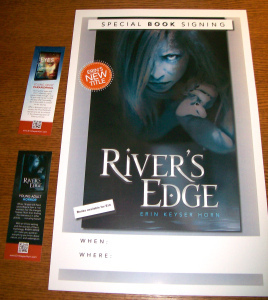
Two-sided bookmarks and new posters for book signings!
Next stop (not counting the gas station, because nothing exciting happened there): Van Meter, Iowa! I talked to the awesome 4th graders at Van Meter school for about an hour. They had a ton of great questions, and we discussed everything from FFA to pets. And maybe a few things about writing. ;-)
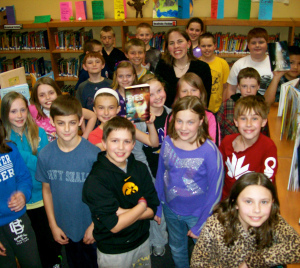
Van Meter 4th graders!!
The whole visit was arranged by Van Meter’s extraordinary librarian, Shannon McClintock Miller. You can read Shannon’s version of events at HER BLOG. She’s smart, funny, and incredibly nice. Many thanks to Shannon and the 4th graders for your time and attention!
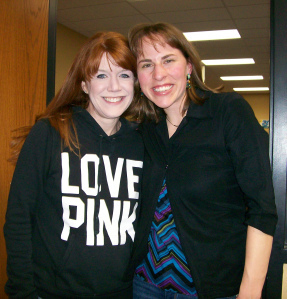
Shannon and me, farm girls united!
Next stop: to visit a writing friend, Kellye. So good to see her after a two-year drought! We had LOTS to catch up on, and she spoiled me with a great supper. Thanks for the wonderful visit, Kellye!!
Last stop of Friday: the old stompin’ grounds of my friend/editor Ellie Ann. The bad news is that Ellie had to cancel her trip to Iowa—her poor kids came down with the flu. I was so sad not to see her, but taking care of your kids is a priority. The good news is that I was still able to stay with Ellie’s parents and siblings, who are among the sweetest and kindest people I’ve ever met. Had a lovely chat with Paul and Cathi that filled me with light and hope for the world.
Saturday morning: woke up at 5:30 AM. This was becoming an unpleasant trend. But Cathi brightened the morning with her smile and a five-star breakfast. MANY thanks to her and her family for hosting me!!
From there I went to Ankeny Authors Fair from 9:00 to noon. This was an event organized by Kirkendall Public Library, and they did a fantastic job. About 45 authors came, offering a wide variety of books.
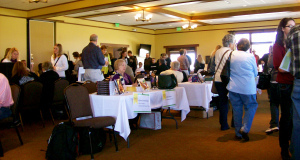
Ankeny Authors Fair! Part of the room inside the Pinnacle Club.
I met several new people and got to see some I already knew: Roland, Mark, Thelma, Sandy, Paul, Jen, Sydney, and Jaden. Thanks so much to everyone who came—I really appreciate the support! I love talking to writers, librarians, and readers!
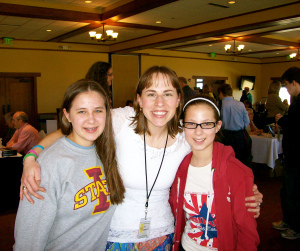
L to R: Sophia, me, Rebekah. Hope you enjoy the books, ladies!!
After the fair was over, I got to eat lunch with Thelma and Sandy (thank you!), and then I began the long trek home. Along the way I stopped at Hy-Vee to get a few groceries. In the parking lot I saw two teenage girls in prom dresses (surprising trivia about me: I’m a tomboy, but somehow a sucker for prom dresses). I instantly thought, Photo Op! Without stopping to think about how crazy I’d look, I grabbed a copy of River’s Edge and my camera and ran across the parking lot before the girls could leave. I said I was giving away a free copy of my new book. One of the girls took it warily, eyeing me with suspicion (rightly so—don’t take candy from strangers, people). Then I asked if I could take their picture. They agreed, probably thinking that the faster they got this encounter over with, the faster the crazy lady would leave.
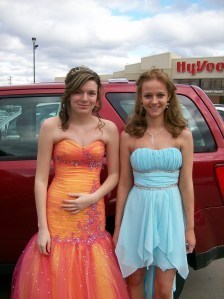
Hope you had fun at prom!
Notice that the book is on top of the car. Maybe they were afraid it had my germs on it, and crazy is catching. But perhaps they’ll read it anyway, just for kicks. The moral of the story is: nowhere are you safe from River’s Edge and my camera, not even at Hy-Vee on your prom night.
Soon afterwards I was home, and glad to be there. But I had SO much fun visiting with SO many great people! Thanks for the extravaganza, Iowa!
Tune into the blog tomorrow for giveaway news and the launch party for River’s Edge!! WOOT!!


April 2, 2013
EYES OF LIGHTNING Ebook Sale with Giveaway
If you haven’t read EYES OF LIGHTNING yet, now is a great time to start! The ebook just went on sale for $2.99! You can buy it from Amazon or Barnes & Noble.
But I need your help to spread the word about this sale. In exchange for your help, you’ll be entered in a contest to win a free paperback of my new book, RIVER’S EDGE!
Contest starts now and ends April 15th at noon. Then I’ll mail the winner a copy of RIVER’S EDGE!
Clicking on the link below will show you a widget with the three ways you can enter the contest. You can do one, two, or all three options. Click on whichever button you want to try, and it will explain how you can qualify to enter. Rafflecopter tracks all entries and will randomly pick a winner on April 15th. That’s all there is to it!
Let me know if you have any questions. Thanks so much for helping me spread the word about the EYES OF LIGHTNING sale, and good luck in the contest!!
CLICK THIS LINK TO ENTER THE CONTEST: a Rafflecopter giveaway



